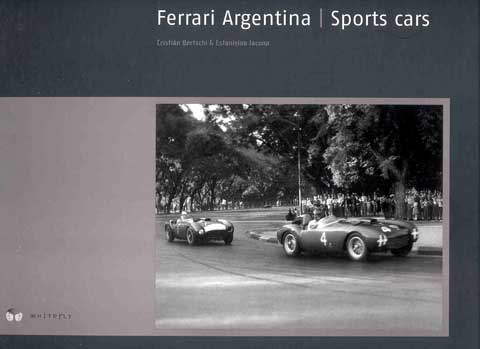
By Cristian Bertschi and Estanislao Iacona
12 x 9.75 inches, hardbound, 340 pages; 304 black and white and 15 color images, published in 2008 by Whitefly, ISBN: 978-950-746-04-0.
Price $175 USD includes shipping worldwide via DHL and available at the VeloceToday Store.
Review by Jeff Allison
All photos courtesy Whitefly
Oh no, not another book that rehashes what we’ve read so many times before about Ferrari! After all, can there be much left that hasn’t been written? Surprise! “Ferrari Argentina | Sports cars” [that is the way the title is presented in the book. ed.] proves that, yes, there is more to be discovered and written, adding important information about sports cars, people and events in Argentina.
It is a refreshing book, revealing information and photographs that few have heard or seen before and breaking new ground by revealing many little known facts and details of Ferraris racing in Argentina.
In 2004, authors Cristián Bertschi and Estanislao Iacona formed Whitefly “…to salvage and preserve and make known the history of car racing in Argentina†by producing a trilogy of books on Alfa Romeo, Ferrari and Maserati in Argentina. “Ferrari Argentina | Sports cars” follows Alfa Romeo as the second of the trilogy although they’ve expanded their projects to include Bugatti (See Pete Vack’s review of “Bugatti Argentina” of January 7, 2009). Whitefly plans “Maserati Argentina” and “Ferrari Argentina | Single Seaters” for future publication.
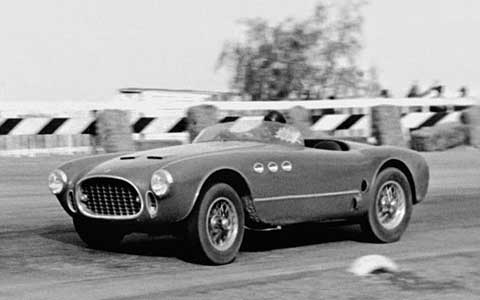 There were several 225 S Vignale spyders in Argentina; this one is S/N 0192 ET, driven here by José MarÃa Ibáñez on June 21st 1953 to second place at Mendoza.
There were several 225 S Vignale spyders in Argentina; this one is S/N 0192 ET, driven here by José MarÃa Ibáñez on June 21st 1953 to second place at Mendoza.
The authors combine their enthusiasm and interests in history, antique cars and photography to produce Whitefly books. Cristián Bertschi is an industrial designer, who teaches history to industrial design students and is enthusiastic about cars and photography. Estanislao Iacona is a labor law attorney with an interest in antique cars. They indicate “…the purpose of this research is to tell the history of the Ferrari marque and its relation with Argentina, and not to test, certify or validate the history, authenticity or pedigree of any of the cars…Our intention is to delve as deep as possible into the subject…â€
“Ferrari Argentina | Sports cars” is a limited-edition, “niche†book that documents an obscure but important piece of Ferrari history—Ferraris racing in Argentina. It features meticulous research and excellent supporting photography, beginning with a 166 Spyder Corsa imported in 1947 and ending with a factory 312 P(B) winning at the 1972 1,000 km de la Ciudad de Buenos Aires.
Marcel Massini wrote the foreword, stating that racing began in South America, including Argentina, in the late 1940s. Argentine President Juan Domingo Perón was the impetus behind many major automobile races with the organization handled by the Automóvil Club Argentino, which imported and owned many of the cars for Argentine drivers to race in the 1950s. At that time, vehicles could not be imported to Argentina without some contact and favor from the government.
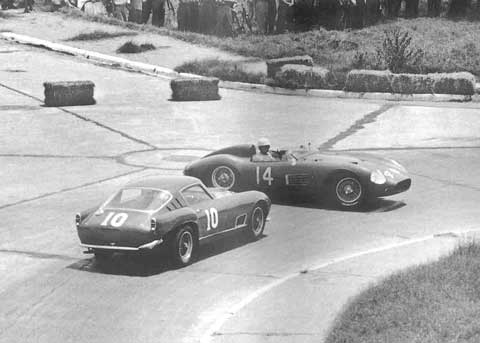 1000Km Buenos Aires, 1958. The 250 GT, S/N 0733 GT of Maurice Trintignant and François Picard will narrowly miss the Maserati 300S of Jorge Magnasco. A few laps later the Maserati would flip and fatally injure Magnasco.
1000Km Buenos Aires, 1958. The 250 GT, S/N 0733 GT of Maurice Trintignant and François Picard will narrowly miss the Maserati 300S of Jorge Magnasco. A few laps later the Maserati would flip and fatally injure Magnasco.
You’ve probably never heard of Roberto Wenceslao Bonomi, José MarÃa Ibáñez, Alberto RodrÃguez Larreta, Angel Maiocchi, Luis Milán, Ãlvaro Piano, César Reyes, Enrique DÃaz Sáenz Valiente and many other Argentine drivers. But, you’ve surely heard of the legendary Juan Manuel Fangio (Lancia-Ferrari world champion in 1956) and José Froilán González, who both hailed from Argentina. It was their racing in Europe that helped bring Ferraris to Argentina and to inspire Argentine drivers to race them. The drivers raced at improved and unimproved tracks and venues around Argentina, such as Autódromo de la Ciudad de Buenos Aires, Autódromo Eva Perón, Parque de la Independencia and many others. These unlikely drivers and venues provide the basis for the book.
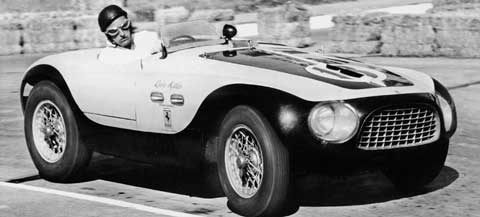 January 23, 1955, the four cylinder 625 TF Vignale spyder, S/N 0304 TF, is being driven by owner Luis Milán at the 1000 KM de la Ciudad de Buenos Aires.
January 23, 1955, the four cylinder 625 TF Vignale spyder, S/N 0304 TF, is being driven by owner Luis Milán at the 1000 KM de la Ciudad de Buenos Aires.
The book is simply organized, providing excellent background information, including a chapter on Italian immigration, and then focusing on the individual histories of many of the Ferraris that raced in Argentina. The Ferraris covered are a 166 Spyder Corsa (002 C), 166 MM Touring barchetta (0024 M), 166/195 MM (a 166 MM Touring barchetta [0038 M] that was rebodied as a 212 Vignale coupe and fitted with a 2.3-liter Ferrari V-12 engine), 166/195 Inter Vignale coupe (0071 S), 212 E Motto spyder (0094 E), 225 Sport Vignale spyders (0160 ED, 0172 ET, 0192 ET and 0214 ED), 225 Export Vignale spyder (0216 ED), 250 MM Pinin Farina berlinetta (0256 MM), 625 TF Vignale spyders (0304 TF and 0306 TF), 375 MM Pinin Farina berlinetta (0358 AM) and spyder (0374 AM) and 375 Plus Pininfarina spyder (0398 AM). Each history details the owners and drivers car-by-car with race-by-race results for each car. The book concludes with a chapter devoted to the 1,000 km de la Ciudad de Buenos Aires for the World Sports Car Championship.
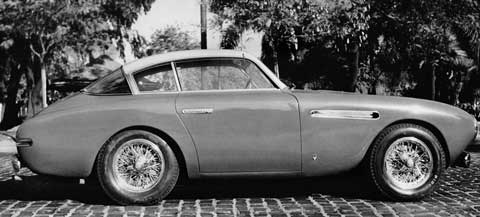 The authors tell the full story about S/N 0038 M which originally was the personal car of Argentine champion José Froilán González.
The authors tell the full story about S/N 0038 M which originally was the personal car of Argentine champion José Froilán González.
The majority of the book and the history of Ferraris racing in Argentina includes this rather rag tag group of cars that were already rather tired and outdated when they were imported into Argentina. Also, they were on the far end of the supply chain for parts and certainly for technical expertise. The cars were maintained or modified without regard to originality and authenticity but to keep them or their pieces on the race tracks, such as Carlos Najurieta’s Maserati/Ferrari hybrid—a 375 MM 4.5-liter V-12 engine (0374 AM) in a Maserati 1,500-cc single-seat chassis.
A 166 Spyder Corsa (002 C) was the first Ferrari to arrive in Argentina in December 1947. Italian nobleman Count Gabriele Besana tested the car for the four-race 1948 Temporada Argentina season, but suspension and engine problems kept him from competing. Sadly, he had several accidents with 002C and never raced it in Argentina, but his efforts cast the die for Ferraris to come to Argentina and race. Besana is recognized as the first amateur driver to introduce a Ferrari sports car to Argentina.
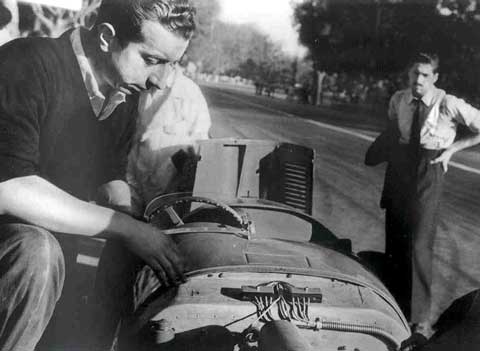
A rare photo of the Italian nobleman Gabriele Besana, here working on the first Ferrari in Argentina, the 166 Spyder Corsa, S/N 002 C.
The first Ferrari victory was on January 15, 1950, when “Charlie†(Carlos) Menditeguy won on the street circuit at Playa Grande, Mar del Plata, driving a 166 MM (0024 M) provided by the Automóvil Club Argentino. However, the authors indicate it was the Ferraris brought by a delegation from the SCCA to race against members of the Club de Automóviles Sport Argentina in the Costanera de Buenos Aires in 1951 that sparked the interest in Ferrari for drivers and fans alike. The event included Americans George Rand in Briggs Cunningham’s 166 Spyder Corsa (016 I), Jim Kimberly in 166 MM/195 S Touring berlinetta Le Mans (0060 M) and Bill Spear in 166 MM Touring barchetta (0054 M). Soon, Ferraris were being imported into Argentina for competition in local championships and later in international races. It shouldn’t go unmentioned that a large number of Italians immigrated to Argentina in the late 19th and early 20th centuries, influencing Argentina’s culture and bringing with them a passion and love for the automobile, especially Ferrari.
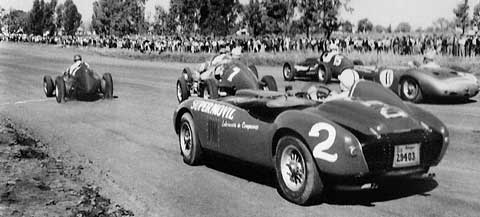 S/N 0398 AM was a 375 Plus Pinn Farina spyder that won the 1955 1000 KM de la Ciudad de Buenos Aires. In 1959, at this race in Esperanza, driver Luis Milán retired after flipping the car four times. Both survived.
S/N 0398 AM was a 375 Plus Pinn Farina spyder that won the 1955 1000 KM de la Ciudad de Buenos Aires. In 1959, at this race in Esperanza, driver Luis Milán retired after flipping the car four times. Both survived.
Ferraris won and placed well frequently. The first to win an Argentine Sports Championship driving a Ferrari was Bonomi in 1952, driving a 212 E spyder (0094 E), fitted with a Motto body. In 1953, Ibáñez and his 225 S Vignale spyder (0192 ET) won. Najurieta garnered the title in 1954 in his 375 MM Pinin Farina spyder (0374 AM). Milán, in his 625 TF Vignale spyder 0304 TF and 375 Plus Pinin Farina spyder (0398 AM), won in 1956.The photo shows Najurieta dirt tracking his 375 MM (0374 AM) at the 500 Millas de Rafaela giving an idea of the wild and wooly conditions that existed at some of the venues in the 1950s. It must have been a nightmare to maintain the cars with little mechanical knowledge and a dearth of parts.
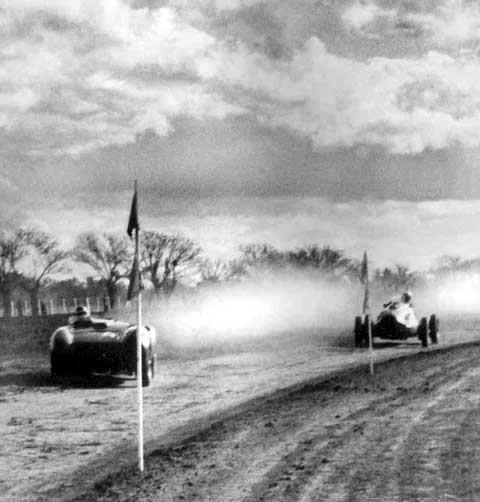
Najurieta dirt tracking his 375 MM (0374 AM). Both drivers and conditions were often wild and wooly.
The concluding chapter features Argentina’s La gran carrera (the great race), providing a narrative of each of the eight races of the 1,000 km de la Ciudad de Buenos Aires for the World Sports Car Championship. The results of each race, which were first run in 1954 with the last in 1972, are also provided. The narrative is accompanied by many great images of the Ferraris that raced in the La gran Carrera. There is no discussion of the history of these cars, but the expanded captions and narrative provide valuable information about the cars, drivers and events. Ferrari won six of the eight races with the last Ferrari win a dominating 1-2 finish by the works 312 P(B)s in the 1972 1,000 km de la Ciudad de Buenos Aires on the way to winning the 1972 World Sports Car Championship.
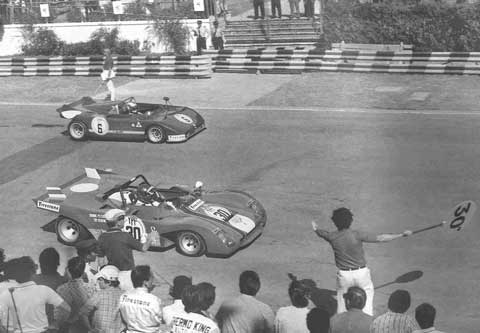 The 312 P(B) of Ronnie Peterson and Tim Schenken wins the 1972 1000 KM de la Ciudad de Buenos Aires.
The 312 P(B) of Ronnie Peterson and Tim Schenken wins the 1972 1000 KM de la Ciudad de Buenos Aires.
The text, mirrored in Spanish and English, is informative and well researched and is lavishly and generously complemented by rarely seen black and white images. Many of the images are by Vicente Ãlvarez, one of South America’s best motor racing photographers. Ferrari serial number mavens will find some utility in the text and photos that document the histories and race results—or it may drive them crazy!
Compared to Ferraris that raced in Europe and the U.S., few knew the details of the Ferraris that raced in Argentina. As Whitefly exists to “…salvage, preserve and make known the history of car racing in Argentina,†it has done just that. The book brings an obscure but important piece of Ferrari history alive with its detailed and comprehensive research, using first-hand accounts of those who were there when possible and from photographs, newspapers, magazines and books, and the wonderful images that accompany the text.
“Ferrari Argentina | Sports cars” is a “must have†book for the devoted tifosi as it provides invaluable information on a heretofore little known, but important, chapter in Ferrari history. For the more casual motor racing fan regardless of their favorite marque, it’s full of great photos documenting the Ferraris that raced in Argentina. I can’t wait for “Ferrari Argentina | Single Seaters” ! Or, “Maserati Argentina” for that matter!
Whitefly is offering a $75 saving if all three books—Alfa Romeo Argentina, Bugatti Argentina and Ferrari Argentina—Sports Cars—are ordered at the same time. Contact vack@cox.net for details.
Jeff Allison has written about and photographed vintage and historic sports racing cars and events for some 40 publications since 1976. He’s served in editorial positions for “MG Abingdon Classics”, “Vintage Motorsport” and is presently the editor of “Prancing Horse”, the magazine of the Ferrari Club of America.
Editor’s note: Portions of this review first appeared in “Prancing Horse”, the magazine of the Ferrari Club of America.